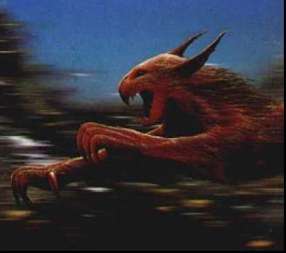Motion Blur

You know how, in comics and western animation, they indicate that something is moving really fast by showing it as just a blur, perhaps with contrails?
Motion Blur is the recording of this phenomenon.
Interestingly, it gets used in live-action film, too. This usually requires special effects, as anything in Real Life that moves fast enough to be seen only as a blur is usually barely seen at all, and that usually isn't what the filmmakers are aiming for.
Human Hummingbird, Speed Echoes, Speed Stripes, Sword Lines and Wheel-O-Feet are subtropes.
Examples of Motion Blur include:
Film
- Between 1980 and 1993, "Go Motion" (a process developed by Industrial Light & Magic and Phil Tippett for use in The Empire Strikes Back) was used in a number of films to add motion blur to the subjects of traditional stop-motion animation in order to get a more realistic portrayal of movement. It was eventually abandoned after the advent of computer-generated effects, as it is far more expensive and time-consuming than CGI.
- Not completely abandoned. It's used in the Wallace and Gromit shorts (see below).
Live Action TV
- An episode of the X-Files involving teenagers that could slow time down for everyone but themselves, had a key plot-point where school security footage was found to show a strange blur. Using experimental technology to colorize it the agents reveal the blur is made up of the school colors, implying that it comes from the jacket of one of the superpowered teens.
- Smallville is a fan of this any time Clark, Kara, or Bart use their superspeed. At one point Jimmy Olsen even caught a picture of Clark in action, but all the picture showed was a red and blue blur, which led to everyone referring to him as The Red-Blue Blur. Later this was shortened to just The Blur. Clark's still not going by Superman on the show yet, so The Blur works fine for him.
Video Games
- Sonic the Hedgehog can do this. He's even nicknamed "The Blue Blur".
- In some of the 3D games, Sonic can create a blur by Spin Dashing. In fact, everyone who can use the Homing Attack has their own Motion Blur.
- Gamespite has an interesting discussion of how Street Fighter 3's Makoto is animated so as to suggest more movement than there are animation frames. Check out some examples here.
- Games with limited animation tend to blur fast moving body parts in addition to applying speed lines. When a blurred character or body part remains slow enough for the player to control the effect is quite surreal.
- Crysis implemented a motion blur system that applied the effect to individual moving objects instead of simply the entire scene as the player moved the mouse around. With config file tweaking, the full-screen motion blur could be turned off while leaving the per-object motion blur on.
Western Animation
- The various animated appearance of the Flash from the DC Universe have used this to suggest his super-speed.
- Done with Superman from time to time too.
- Quicksilver, another speedster from the Marvel Universe, uses motion blur in the same way.
- In Looney Tunes the quick characters are portrayed this way:
- Road Runner;
- Speedy Gonzales;
- Anyone who needed to leave/arrive in a hurry, really.
- The Chuck Jones Merrie Melodies short "The Dover Boys" pioneered the use of the smear, in which the characters appear elongated for two or three frames as they zip from one pose to the next. The technique has been used by animators ever since, most notably on Johnny Bravo.
- For the chase scenes in the Wallace and Gromit shorts, the camera was attached to whatever vehicle was involved (a toy train, a motorcycle, etc.) and moved along during exposure, resulting in a blurred background - basically a revival of the "Go-motion" technique, as the audio commentary for "A Matter of Loaf and Death" points out.
This article is issued from Allthetropes. The text is licensed under Creative Commons - Attribution - Sharealike. Additional terms may apply for the media files.